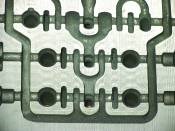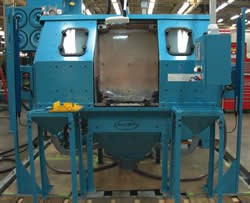New Approach to Internal Deburring and Cleaning
Opposing blast nozzles put turbulence to work.
A patented process for rapidly cleaning and deburring complex internal passages in castings and other components is being marketed by Hammond Roto-Finish (Kalamazoo, MI).
Developed by Steve Carpenter, president of Hammond distributor Grand Northern Products (Grand Rapids, MI), the Recipro-Blast process uses opposing blast streams to create turbulence inside the component being processed. The turbulence created by the opposing streams aggressively removes internal burrs, burned-on sand and leftover mold or core materials from difficult-to-reach passages and highly cored and deep components. Nozzle and part movement are servo-controlled.
Carpenter explains that the system grew out of his foundry experience. “When I worked in foundries, first as a chief engineer and then as a plant manager, a common problem was cleaning interior part passages, especially small IDs with long or irregular sections,” he says. “In an effort to create turbulence that could be controlled, we tried introducing blast streams from opposing ends with some amazing results.”
Carpenter continued to develop the process, then patented it and sold the marketing rights to Hammond. He says it can replace labor-intensive hand cleaning, molten salt cleaning, rotary brushes, extensive external wheel blasting and other processes such as thermal deburring.
In simple terms, the process uses two or more opposing blast nozzles to impart reflective, random energy to the blast media at a chosen area inside the part. According to Carpenter, Recipro-Blast is much more effective and much faster than conventional blasting for internal deburring and cleaning.
“With a conventional lance, energy is lost because the abrasive is forced to turn an abrupt corner at the nozzle tip,” he explains. “This decelerates the blast media and reduces its effectiveness. However, two opposing nozzles create a mushroom effect and gives the added benefit of a 360° blast pattern, if desired.”
Nozzles used in the process do not have to be directly opposing, Carpenter says. “This is advantageous where part configurations don’t allow opposing nozzles, such as water jacket passages and oil galleries in engine blocks and turbocharger housings.”
Hammond has several systems in operation and is marketing the process to manufactures of hydraulic/pneumatic manifolds, valve fittings and bodies, and transmission components.
According to Carpenter, the process is also applicable for peening of internal surfaces. “Peening of normal surfaces is usually accomplished with a small-diameter lance with outlets exiting the lance at an angle,” he explains. “In peening, ideal effects are accomplished with the stream striking the desired surface at an angle approaching 90°. In the Recipro-Blast system, the angle can be varied by adjusting the pressure from side to side or changing the nozzle diameter. And, the system allows the abrasive to strike in a 360° pattern if desired, and at angles up to and past 90° with significant intensity and speed of coverage.”
In one application, the process reduced time to treat internal surfaces of fuel system components from 10 min with a conventional lance to 10 sec.
Other applications for Recipro-Blast involves deburring of internal surfaces of precision components such as valves, metering devices, rectangular and tubular parts. “Most openings in tubular parts—holes, slots and others—are created from outside to inside, leaving burrs on the interior surface,” Carpenter says. “These can be removed using any of several methods, including thermal deburring, mechanical brushing, hand deburring, high-pressure water, conventional blasting, vibratory finishing and additional machine operations. All these have advantages and disadvantages, but the Recipro-Blast allowed consistent burr removal in a matter of seconds per part with a relatively low cost of installation.”
The system can use a variety of media for abrasive blasting and peening. Media choices include ceramic beads; glass beads; carbon, stainless steel and zinc cut wire; cast aluminum, stainless or steel beads; and dry ice.
Read Next
Delivering Increased Benefits to Greenhouse Films
Baystar's Borstar technology is helping customers deliver better, more reliable production methods to greenhouse agriculture.
Read MoreA ‘Clean’ Agenda Offers Unique Presentations in Chicago
The 2024 Parts Cleaning Conference, co-located with the International Manufacturing Technology Show, includes presentations by several speakers who are new to the conference and topics that have not been covered in past editions of this event.
Read MoreEpisode 45: An Interview with Chandler Mancuso, MacDermid Envio Solutions
Chandler Mancuso, technical director with MacDermid Envio discusses updating your wastewater treatment system and implementing materials recycling solutions to increase efficiencies, control costs and reduce environmental impact.
Read More




















.jpg;maxWidth=300;quality=90)




